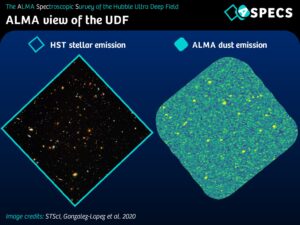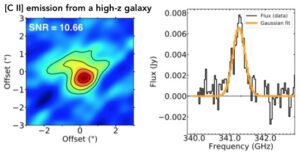 Stars form from the gravitational collapse of cold gas clouds, that appears in mostly molecular form and rich in dust. By studying this cold component (with temperatures < 100 K) we study the fuel for star formation, a fundamental step in our understanding of galaxy evolution. The dominant molecule, H2, is an inefficient radiator. Therefore, observations of the cold interstellar medium rely on other tracers: The rotovibrational line emission from other molecules, such as carbon monoxide (CO); the emission of fine-structure lines that are collisionally excited (such as [CII] at 158 um, [NII] at 122 and 205 um, [OIII] at 52 and 88 um); and the continuum emisssion of dust, which dominates the Spectral Energy Distribution (SED) of galaxies in the mid- and far-infrared bands.
Stars form from the gravitational collapse of cold gas clouds, that appears in mostly molecular form and rich in dust. By studying this cold component (with temperatures < 100 K) we study the fuel for star formation, a fundamental step in our understanding of galaxy evolution. The dominant molecule, H2, is an inefficient radiator. Therefore, observations of the cold interstellar medium rely on other tracers: The rotovibrational line emission from other molecules, such as carbon monoxide (CO); the emission of fine-structure lines that are collisionally excited (such as [CII] at 158 um, [NII] at 122 and 205 um, [OIII] at 52 and 88 um); and the continuum emisssion of dust, which dominates the Spectral Energy Distribution (SED) of galaxies in the mid- and far-infrared bands.
OAS is part of and leads various studies of galactic evolution via the cold interstellar medium, taking advantage of satellites (such as Spitzer and Herschel) as well as ground-based facilities (the Jansky Very Large Array, the IRAM/Northern Extended Millimeter Array, the Atacama Large Millimeter Array, and others).
Among other projects led by OAS, we list:

